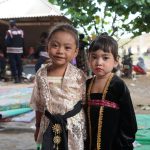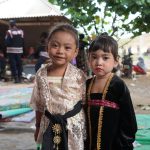Cultural identity is a multifaceted concept that encompasses the shared beliefs, values, customs, and practices that define a group of people. It is shaped by various factors, including ethnicity, nationality, language, and religion, and serves as a lens through which individuals perceive the world around them. At its core, cultural identity provides a sense of belonging and continuity, linking individuals to their ancestors and their community.
This connection is not merely historical; it is a living, breathing aspect of daily life that influences how people interact with one another and navigate their environments. The nuances of cultural identity can be seen in everything from traditional clothing and culinary practices to language and social norms, all of which contribute to a rich tapestry of human experience. Moreover, cultural identity is not static; it evolves over time as societies change and adapt to new influences.
The interplay between personal experiences and collective narratives shapes how individuals understand themselves within the broader context of their culture. For instance, a person may identify strongly with their ethnic background while simultaneously embracing elements from other cultures encountered through travel or migration. This dynamic nature of cultural identity highlights the importance of recognizing both the historical roots and contemporary expressions of culture.
As globalization continues to blur the lines between distinct cultural groups, understanding cultural identity becomes increasingly complex yet essential for fostering mutual respect and appreciation among diverse populations.
Key Takeaways
- Cultural identity is shaped by a combination of factors including language, customs, traditions, and values.
- Family and community play a significant role in shaping an individual’s cultural identity and sense of belonging.
- Navigating cultural stereotypes requires open-mindedness, empathy, and a willingness to challenge preconceived notions.
- Embracing diversity and inclusion is essential for creating a more harmonious and understanding society.
- Balancing tradition and modernity involves respecting cultural heritage while also adapting to the changing world.
The Influence of Family and Community
Family and community play pivotal roles in shaping an individual’s cultural identity. From an early age, children are immersed in the traditions and values of their families, which serve as the primary source of cultural transmission. Parents often instill in their children a sense of pride in their heritage, teaching them the significance of rituals, language, and customs that have been passed down through generations.
This familial influence is crucial in forming a child’s worldview, as it lays the groundwork for their understanding of social norms and expectations. In many cultures, family gatherings and celebrations are not just occasions for joy but also opportunities to reinforce cultural values and strengthen bonds among relatives. Beyond the family unit, the broader community also plays a significant role in shaping cultural identity.
Communities often serve as microcosms of larger societal values, where individuals find support and solidarity among those who share similar backgrounds. Local traditions, festivals, and communal activities foster a sense of belonging and collective identity that transcends individual experiences. For instance, participation in community events can reinforce cultural pride and provide a platform for sharing stories and experiences that highlight the richness of one’s heritage.
In this way, both family and community act as vital conduits for cultural expression, ensuring that traditions are not only preserved but also adapted to meet the needs of future generations.
Navigating Cultural Stereotypes

Cultural stereotypes can pose significant challenges for individuals as they navigate their identities within a diverse society. These oversimplified perceptions often arise from a lack of understanding or exposure to different cultures, leading to generalized assumptions about behaviors, values, or abilities based on ethnicity or nationality. Such stereotypes can be harmful, as they reduce complex individuals to mere caricatures, stripping away their unique experiences and contributions.
For many, confronting these stereotypes becomes an essential part of their journey toward self-acceptance and empowerment. By challenging preconceived notions and advocating for a more nuanced understanding of cultural identities, individuals can reclaim their narratives and assert their place within society. Moreover, the impact of cultural stereotypes extends beyond individual experiences; it can shape societal attitudes and policies as well.
When stereotypes are perpetuated in media representations or public discourse, they can influence how entire communities are perceived and treated. This can lead to systemic discrimination or marginalization, further entrenching social divides. To combat this cycle, it is crucial for individuals to engage in open dialogues about culture and identity while promoting education that fosters empathy and understanding.
By sharing personal stories and highlighting the diversity within cultural groups, individuals can work towards dismantling stereotypes and creating a more inclusive environment where all identities are celebrated rather than constrained by narrow definitions.
Embracing Diversity and Inclusion
| Metrics | 2019 | 2020 | 2021 |
|---|---|---|---|
| Diversity in Hiring | 25% | 30% | 35% |
| Inclusion Training | 50% | 60% | 70% |
| Employee Satisfaction | 75% | 80% | 85% |
Embracing diversity and inclusion is essential for fostering a society that values the richness of various cultural identities. In an increasingly interconnected world, recognizing the importance of diverse perspectives can lead to greater innovation, creativity, and problem-solving capabilities. When individuals from different backgrounds come together, they bring unique experiences and viewpoints that can challenge conventional thinking and inspire new ideas.
This collaborative spirit not only enhances personal growth but also contributes to the overall well-being of communities by promoting social cohesion and mutual respect. Celebrating diversity means acknowledging the strengths that come from varied cultural expressions while actively working to create spaces where everyone feels valued. Inclusion goes hand in hand with diversity; it is not enough to simply acknowledge differences without creating an environment where all voices are heard and respected.
Organizations, educational institutions, and communities must implement policies that promote equitable representation and participation across all levels. This includes actively seeking out diverse perspectives in decision-making processes and ensuring that marginalized voices are amplified rather than silenced. By fostering an inclusive atmosphere, societies can cultivate a sense of belonging for all individuals, allowing them to thrive while contributing their unique gifts to the collective whole.
Ultimately, embracing diversity and inclusion enriches our shared human experience, paving the way for a more harmonious coexistence.
Balancing Tradition and Modernity
The tension between tradition and modernity is a common theme in discussions about cultural identity. As societies evolve due to technological advancements and globalization, individuals often find themselves at a crossroads where they must navigate the complexities of maintaining traditional practices while adapting to contemporary realities. For many, this balancing act can be fraught with challenges; there may be pressure from older generations to uphold customs that feel increasingly irrelevant in today’s fast-paced world.
Conversely, younger generations may feel drawn to modern influences that seem more aligned with their aspirations but risk alienating them from their heritage. Finding harmony between tradition and modernity requires thoughtful reflection and open dialogue within families and communities. It is essential to recognize that traditions are not monolithic; they can be reinterpreted or adapted to fit new contexts without losing their essence.
For instance, traditional art forms may evolve through contemporary mediums or themes while still honoring their origins. By embracing this fluidity, individuals can create a cultural identity that honors the past while remaining relevant in the present. This approach not only enriches personal experiences but also fosters intergenerational connections as families navigate these changes together, ultimately leading to a more vibrant cultural landscape.
The Impact of Globalization on Cultural Identity

Globalization has profoundly transformed cultural identities around the world by facilitating unprecedented levels of interaction among diverse populations. While this interconnectedness has led to greater exposure to different cultures—resulting in hybrid identities that blend elements from various traditions—it has also raised concerns about cultural homogenization. As global brands dominate local markets and media representations become increasingly uniform, there is a risk that unique cultural practices may be overshadowed or lost altogether.
This phenomenon can create tension within communities as individuals grapple with preserving their distinct identities in an era where global influences are pervasive. However, globalization also presents opportunities for cultural exchange and enrichment. The sharing of ideas, art forms, culinary practices, and languages can foster greater understanding among different cultures while promoting appreciation for diversity.
Social media platforms have become powerful tools for individuals to showcase their heritage on a global stage, allowing them to connect with others who share similar backgrounds or interests. This digital landscape enables marginalized voices to be heard while challenging dominant narratives that may perpetuate stereotypes or misconceptions about specific cultures. Ultimately, navigating the complexities of globalization requires a conscious effort to celebrate local traditions while engaging with global influences in ways that honor both heritage and innovation.
Strategies for Preserving and Celebrating Cultural Heritage
Preserving and celebrating cultural heritage is vital for maintaining the richness of human experience across generations. One effective strategy involves education—both formal and informal—that emphasizes the importance of cultural history and practices. Schools can incorporate multicultural curricula that highlight diverse histories, languages, art forms, and traditions while encouraging students to explore their own backgrounds.
Community organizations can also play a crucial role by hosting workshops, festivals, or events that celebrate local customs and invite participation from all members of society. By fostering an environment where cultural heritage is valued and shared openly, communities can cultivate pride in their identities while ensuring that traditions are passed down effectively. Another important strategy is leveraging technology to document and share cultural practices with wider audiences.
Digital storytelling platforms allow individuals to create multimedia narratives that capture their unique experiences while preserving traditional knowledge for future generations. Social media can serve as a powerful tool for raising awareness about cultural events or initiatives aimed at preserving heritage—connecting people across geographical boundaries who share similar interests or backgrounds. Additionally, partnerships between local governments, cultural institutions, and community organizations can facilitate funding for preservation projects or initiatives aimed at revitalizing traditional practices that may be at risk of fading away.
By employing these strategies collectively, societies can ensure that cultural heritage remains vibrant while adapting to contemporary realities—ultimately enriching our shared human experience for years to come.
If you’re interested in exploring more about culture and cultural identity, I recommend visiting a page that delves into the essence of these topics. Although the specific content of the page isn’t detailed here, you can access it by clicking on this link: About Us – APEAI. This page might offer insights into how the organization views and interacts with cultural issues, potentially reflecting their mission and values related to cultural identity.
FAQs
What is culture?
Culture refers to the beliefs, customs, traditions, and way of life of a particular group of people. It encompasses language, religion, cuisine, social habits, music, and arts.
What is cultural identity?
Cultural identity is the feeling of belonging to a particular culture or group. It is shaped by a person’s upbringing, traditions, values, and experiences within a specific cultural context.
How does culture influence individuals?
Culture influences individuals in various ways, including shaping their beliefs, values, behaviors, and worldview. It also impacts their communication styles, social interactions, and perceptions of the world.
Why is cultural identity important?
Cultural identity is important as it provides individuals with a sense of belonging, pride, and connection to their heritage. It also helps to shape one’s self-concept and understanding of their place in the world.
How do people express their cultural identity?
People express their cultural identity through various means, such as language, clothing, food, music, art, rituals, and celebrations. These expressions serve as a way to showcase and preserve their cultural heritage.
Can cultural identity change over time?
Yes, cultural identity can change over time due to factors such as migration, globalization, intercultural relationships, and exposure to different cultures. Individuals may adapt and incorporate new cultural elements into their identity.









